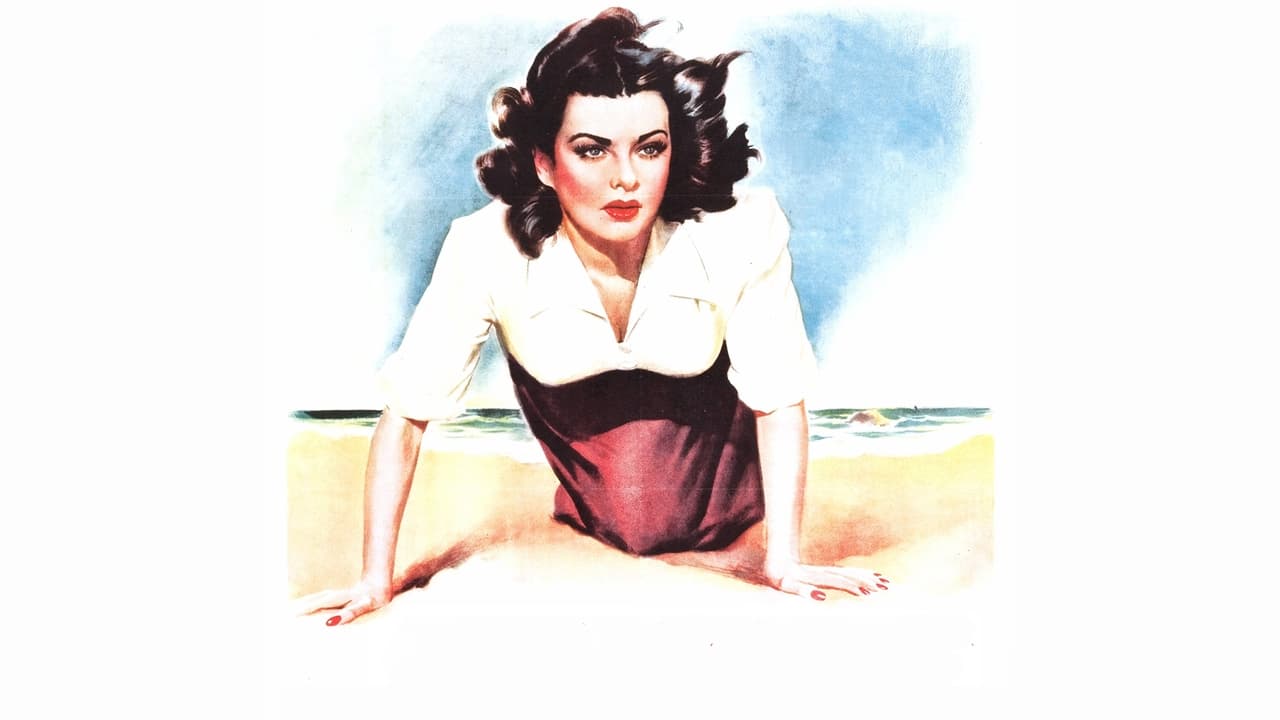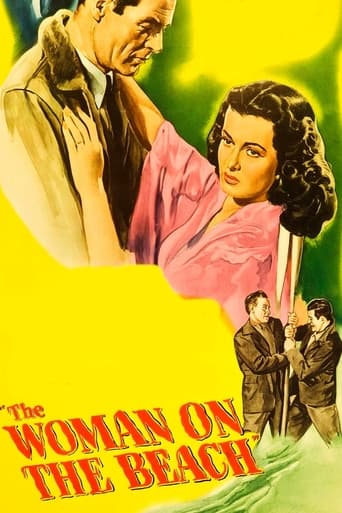

The Woman on the Beach (1947)An interesting psycho-drama. The plot is a contrivance, limited to one general scene on an ocean beach, where a soldier (Robert Ryan) is struggling with terrible memories of the war. He is apparently in love with one woman but then he meets a far more beguiling and mysterious woman (Joan Bennett), already married to a man who has recently gone blind.So there are the four characters. Each is loaded with qualities that are plain to see and that guide their decisions in extreme ways. Ryan, as an actor, is not to everyone's taste, but he has grown on me over the years. The stiff posture and equally stiff verbal delivery is laced with feeling, like he's constantly wound up too tight. That's perfect here for a man still tormented by violent dreams and uncertainty in his lonely life. Bennett plays a kind of woman who isn't quite femme fatale because she isn't quite manipulating Ryan without his knowing, but she has a sinister look and tone to her voice that's terrific. It turns out she hates her husband, not having to do with his blindness, but because he's cruel to her. So it naturally occurs to both Ryan and Bennett in different ways that the blind husband might be dispensable somehow, even if neither is quite prepared for murder.The husband is given an earthy, almost admirable quality that is wonderfully at odds with how he treats Bennett. And the fourth leading character, the sweet woman who is slowly seeing Ryan slip out of her future, is the one symbol of straight forward simplicity and honesty. There are scenes along the cliffs, on the stormy waters, at night in the grasses, and in a shipwrecked hull. You feel sometimes that it's almost a play, scripted tightly (too tightly) and staged in a limited physical world (with even the ocean scene seeming constrained in space). But this works, in a way, because you know it's a study of sorts, not a slice of real life. The one real flaw is having the blind man just too able to walk and do things without his eyes, never stumbling, never missing by an inch something he's reaching for.This movie was a surprise in many ways. I haven't seen one quite like it, and Ryan and Bennett are really both vivid and strangely deep. If the end leaves you unsatisfied, you're not alone. It's too easy, and it shows no psychological insight after all the probing and groping prior. Even so, it's strong enough to work as a stylized piece, an artifice with bits of truth tucked in the edges.
... View MoreThe Woman on the Beach A coast guard lieutenant gets caught in the middle of a tempestuous marriage. The film has a lot of psychological angles and is anchored by three strong characters with fine performances by Ryan, Bennett and Bickford. However, the story just never takes off and seems to float around without a destination. The emotions bubbling under the surface rarely materialize into compelling plot material and I was fighting boredom a lot of the time. I also found the cinematography uninspired (except for Ryan's surreal nightmare) and the score far too oppressive.6/10
... View MoreThe leading actor-actress of the film were Joan Bennett and Robert Ryan. However, Charles Bickford (Tod) had a tremendous performance as a former painter, blind, with a sixth sense highly developed. The director Jean Renoir tried to combine human feelings with thriller in this film based on the novel "None so blind" of Mitchell Wilson. From the very beginning it was not difficult to guess what Peggy (Joan Bennett), Tod's wife, and the navy's lieutenant Scott wanted. Peggy was ambitious, she loved and hated Tod at the same time, while Scott was looking for the real love of his life. The relationship of Peggy with Scott looked opportunistic rather than due to sentimental attraction. Tod was bound to Peggy, but why? this is probably what the film wanted to demonstrate, once one breaks what is shared with your partner you will be free as Tod finally became. The film looks to be incoherent initially, e.g. Scott often had nightmares, and they never had any real connection with the main plot of the film.
... View MoreBy 1947, Jean Renoir, at least indirectly, wasn't new to the American film noir style. Two years earlier, Fritz Lang had released the first of his two Renoir remakes, 'Scarlet Street (1945),' which was based upon 'La Chienne / The Bitch (1931)' {the second film, 'Human Desire (1954),' was inspired by 'La Bête humaine (1938)'}. 'Scarlet Street' notably starred Joan Bennett in a prominent role, which makes it interesting that, despite allegedly disliking that film, Renoir himself used her in his own Hollywood film noir, 'The Woman on the Beach (1947).' It's a visually-magnificent film, with photography from Leo Tover and Harry Wild (the latter of whom shot 'Murder, My Sweet (1944)' and 'Macao (1952)') that perfectly captures the mystery and eerie calm of the beach-side setting, frequently swathed in gentle clouds of mist that foreshadow the ambiguity and uncertainty of the story that follows. When we first glimpse Joan Bennett on the fog-swathed coast, collecting driftwood at the wreck of a grounded ship, she really does look ghostly and ethereal, a premonition that may or may not be real.Robert Ryan plays Scott, a coastguard who suffers from regular night terrors concerning memories of a war-time naval tragedy, when his ship was presumably torpedoed. His dream sequences are gripping and otherwordly, recalling the excellently surreal work achieved by Renoir in his silent short film, 'The Little Match Girl (1928).' During his nightmares, Scott imagines an underwater romantic liaison, which, before he can get intimate, unexpectedly blows up in his face; this is an apt indication of the events that unfold later in the film. Scott is engaged to marry the pretty Eve (Nan Leslie), but his attention is soon distracted by Peggy (Joan Bennett), the titular "woman on the beach." Peggy is married to Tod (Charles Bickford), a famous blind artist who is still coming to terms with his relatively recent affliction. At just 71 minutes in length, 'Woman on the Beach' feels far too short, the apparent victim of studio interference. Scott is obviously enamoured, and later obsessed, with femme fatale Peggy, in a manner than suggests Walter Neff's fixation with Phyllis Dietrichson, but the motivations behind his actions are inadequately explored and explained.Perhaps as a result of the studio's trimming of scenes, many plot-twists in the film seem somewhat contrived. Scott's extreme determination in proving that Tod is faking blindness feels so incredibly illogical why, indeed, would Tod even consider such a con? Many wonderful scenes are severely hampered by the story's lack of exposition. In the film's most dramatic scene, amid the choppy waters of the Atlantic, Robert Ryan displays a frighteningly convincing rage that borders on pure psychosis, a quality that Nicholas Ray exploited five years later in 'On Dangerous Ground (1952).' However, because Scott's obsession and emotional transformation had previously been explored so sparsely, the sequence feels, above all else, out of context. The performances are nevertheless solid across the board, with Bickford probably the most impressive. Bennett's character is tantalisingly ambiguous: throughout the film, she slowly reveals herself to be nothing but a greedy tramp, though Scott insists on treating her as a tormented victim of abuse. The ending offers little in the way of resolution, reaffirming the sentiment that perhaps this film isn't all there.
... View More